m (→Loading Sample) |
|||
| Line 180: | Line 180: | ||
# Once the chamber is vented the loadlock door will open up. Carefully unload the sample holder. At this point close the door and the latch. Keep it this way until the next sample is ready to load. | # Once the chamber is vented the loadlock door will open up. Carefully unload the sample holder. At this point close the door and the latch. Keep it this way until the next sample is ready to load. | ||
== | ==Roughing Load-lock== | ||
# Open the | # Open the load-lock door and place the sample holder on the loading arm with the sample facing towards the back of the room. | ||
# Close | # Close load-lock door and lightly tighten knob. | ||
# Ensure both TMP backing valves are closed. | # Ensure both TMP backing valves are closed. | ||
# Open the load lock roughing valve with a 3/4" wrench and then open fully. Wait for the backing pressure to go below 100 mtorr and start closing the load lock roughing valve. Fully close the roughing valve when the backing pressure is 30 mtorr or less. Close the roughing valve using a 3/4" wrench | # Open the load lock roughing valve with a 3/4" wrench and then open fully. Wait for the backing pressure to go below 100 mtorr and start closing the load lock roughing valve. Fully close the roughing valve when the backing pressure is 30 mtorr or less. Close the roughing valve using a 3/4" wrench | ||
# Open the | # Open the load-lock and evaporation chamber TMP backing valves. | ||
# Open the pneumatic gate valve on the | # Open the pneumatic gate valve on the load-lock TMP inlet. | ||
# Turn on the | # Turn on the load-lock chamber ion gauge. | ||
# Transfer the sample into the evaporation chamber only after | # Transfer the sample into the evaporation chamber only after load-lock pressure has reached 5x10<sup>-7</sup>torr or less. | ||
==Unloading Sample== | ==Unloading Sample== | ||
Revision as of 21:41, 11 February 2014
Molecular beam epitaxyW is a method of thin film deposition that is useful for fabricating high performance photovoltaic devices.
MTU MBE background
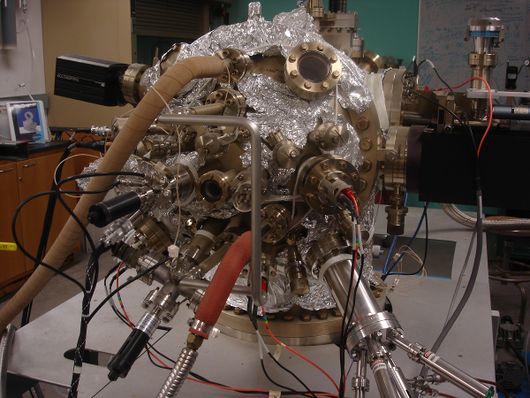
The original MBE at Michigan Tech was assembled in 1993 using ISA Riber, SVT Associates, Thermionics, k-Space, and Inficon components. It provided staff and students the ability to deposit thin high purity films under ultra high vacuumW(UHV) conditions. The system saw use up until April of 2001, at which point it was left under UHV and powered down. In late 2011, over a decade later, the chamber was found to be at atmospheric pressure and the process of reconditioning the system was initiated.
Silver(Ag), molybdenum(Mo), germanium(Ge), tin(Sn), iron(Fe), nickel(Ni), copper(Cu), silicon(Si) and carbon(C) sources were used prior to 2001. The silicon and carbon sources were changed from thermal to SVT Associates electron beam evaporating sources roughly two years after completion of the MBE.
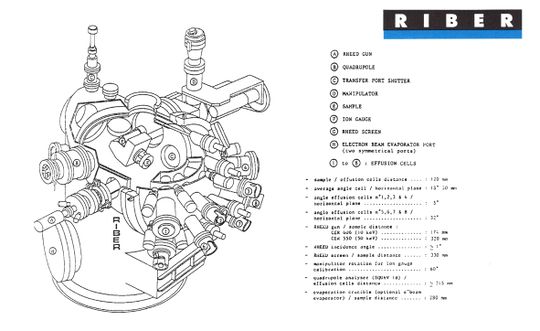
- Note: Diagram shown is a similar model to that of MTU's with the only known deviation from the diagram being the lack of the CF100 roof-top flange.
Installed Equipment
ISA RIBER MBE 32 Growth/Evaporation Chamber
The RIBER MBE 32 system is a highly flexible and efficient 3" single-wafer epi reactor, which provides all the necessary MBE tools and in-situ characterization capabilities to achieve state-of-the-art epitaxy of III-Vs, II-VIs, MCTs, nitrides and silicon alloys. The 8 cell ports are grouped together on the evaporation flange, which also includes cryoshrouds completely surrounding hot parts of the cells, ensuring maximum trapping of all residual species. The pump chamber also contains a cryoshroud to maximize gettering of low atomic weight gasses by the installed titanium sublimation pump system.
Two cryoshrouds are fixed to the inside of the source flange. One cryoshroud is a double-walled, lens-shaped assembly immediately adjacent the evaporation flange and serves to thermally isolate each of the sources while maximizing condensation of residual gasses. The second and main cryopshroud is supported by and connected to the evaporation flange. This cryoshroud has the same construction as the evaporation flange shroud. Each panel has a separate all metal liquid nitrogen inputs and outputs permitting independent or sequential cooling.
The evaporation flange can accommodate eight sources, four each with 2.75" and 4" flanges. It can be specifically adapted for the growth of mercury compounds or nitrides of group III elements. Gas-source MBE and CBE configurations combining the use of solid sources and/or gas sources are also available.
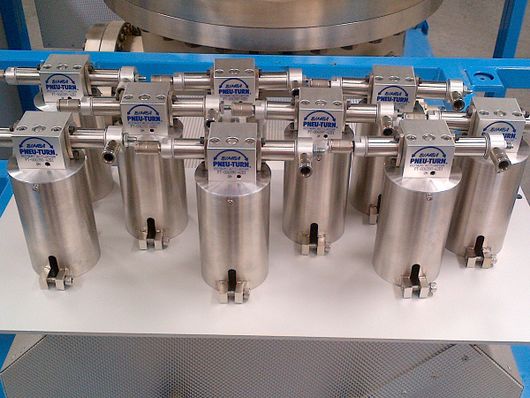
Michigan Tech's MBE system employs Model 16TTD manual shutters provided by ISA Riber and pneumatic rotary actuators(Bimba Pneu-Turn) are also available. The rotary actuators have been found, tested and deemed to be in working condition. A Humphrey Raceway solenoid valve consisting of nine (9) dual-use solenoids and a valve body capable of supplying nine actuators completes the automatic shutter system.
Introduction of samples is accomplished by use of a load lock chamber (R&D systems). This chamber can be vented (typically with UHP N2) and pumped independently of the evaporation chamber. In addition to the transfer arm sample holder, the chamber has attached to it two additional holders, one of which can be heated, for sample pre- and post-treatment. The sample transfer arm is manually operated, permitting limited rotation for alignment with the manipulator's sample holder.
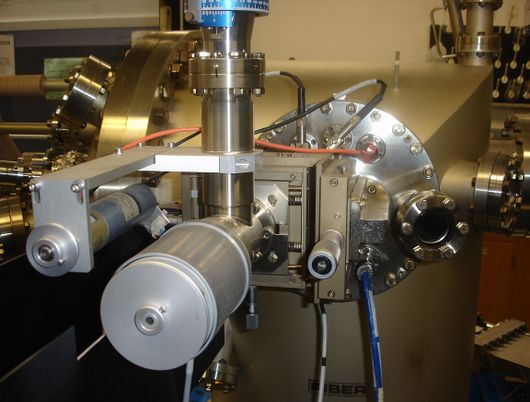
The Ribar ARM3 manipulator provides rotation in two axes, one axis for placing the sample such that it faces towards or away from the sources and the other for rotation on an axis normal to the sample's face. It also permits heating of the sample to a maximum of 1000 degrees C. An Isa Riber MOB-300M molybdenum mounting block is specifically made for use with 3" diameter substrates but can accommodate mounting of smaller (2cm x 2cm) substrates with available carbon blanks.
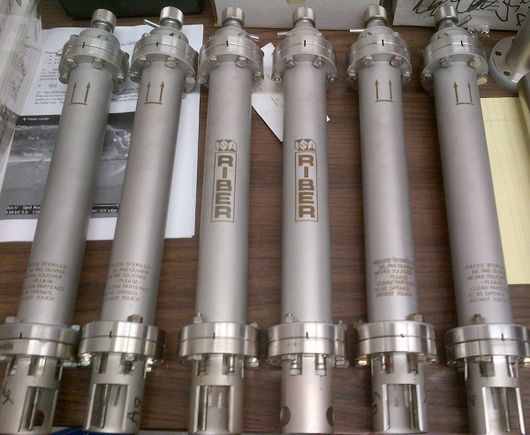
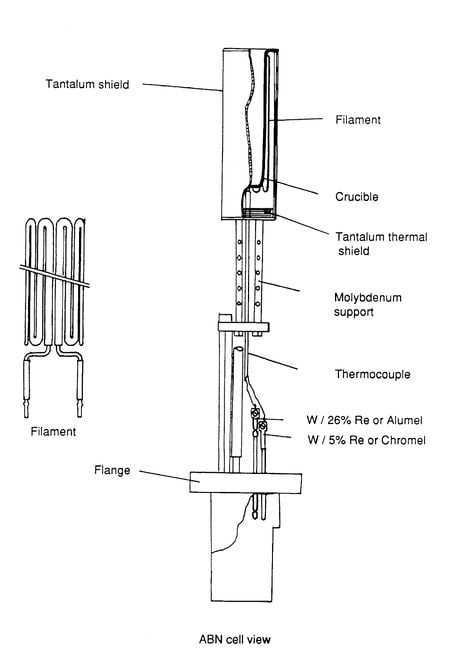
A number of effusion cells are available for use; eight thermal and three e-gun cells. A plasma generator is also available. In situ analyzers consist of an Inficon Transpector residual gas analyzer, an Inficon SQC-310C deposition controller with two quartz crystal sensors and a reflection high energy electron diffraction (RHEED) system. One of the quartz crystal sensors is bellows-mounted and can be placed directly in the position occupied by the sample during film deposition, permitting very accurate deposition rate measurement.
Roughing is provided by a BOC Edwards QDP Drystar vacuum pump. Leybold Turbovac 1000C and Turbovac 361C turbomolecular pumps provide high vacuum pumping for the evaporation and load lock chambers, respectively. Ultra high vacuum conditions in the evaporation chamber are achieved with an ISA Riber PF-6 titanium sublimator and an ISA Riber PI-400-TTZ ion pump.
ISA RIBER PI-400-TTZ Ion Pump
ISA RIBER 401-1000 Ion Pump Power Supply
ISA RIBER PF-6 Titanium Sublimator
ISA RIBER Model 304-6 Titanium Sublimator Power Supply
Supplies power for Titanium filaments. 0 to 60 Amp selectable for 1 of 6 filaments and operates at 220V (50/60 Hz).
ISA RIBER Model JBA 12-1 Bayard-Alpert Ion Gauge
RIBER Model 307S2 Electrometer
ISA RIBER ABN 135L Effusion Cells
CELL TYPE SOLID SOURCE MOUNTING FLANGE CONFLAT 2-3/4" O.D. CF 35 KNIFE EDGE TO LIP LENGTH 283.5 mm EXTERNAL SHIELD DIAMETER 37.2 mm BAKEOUT TEMPERATURE 250°C CAPACITY 39 cc CRUCIBLE INTERNAL LIP DIAMETER 23.6 mm CRUCIBLE INTERNAL LENGTH 88.9 mm CRUCIBLE MATERIAL PBN (pyrolytic boron nitride) TEMPERATURE RANGE 0 - 1400°C TEMPERATURE STABILITY < 0.4°C THERMOCOUPLE TYPE WRe 5/26 HEATING MODE JOULE EFFECT / RADIATION HEATING ASSEMBLY MATERIALS Mo - Ta - PBN FILAMENT TYPE FLAT FOIL MAXIMUM TEMPERATURE 1500°C
ISA RIBER TC 194 Temperature Control Units
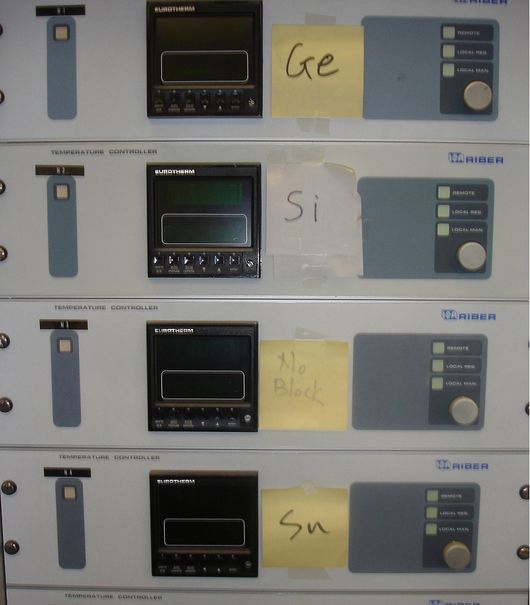
TDK-Lambda EMS 30-33 1000W (1kW) AC to DC Power Supply
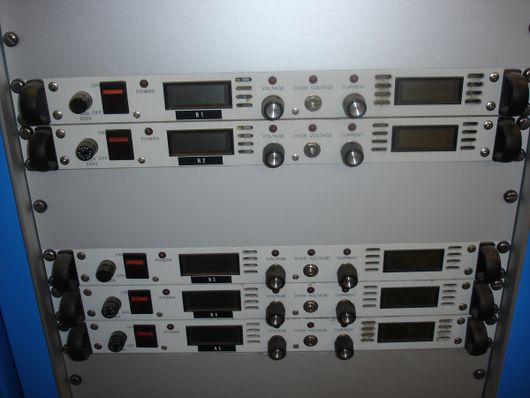
- Michigan Tech currently has five(5) of these power supplies on hand, of which four are being utilized in the present
configuration for heating the manipulator and sources/cells. Current listed specifications are:
AC Input 1 kW models: 115 VAC (standard), 220 VAC (optional) single phase; All models 50/60 Hz
Rated Power (Watts) 1000W (1kW) Output Voltage (Volts) 0 - 30V Output Current (Amps) 0 - 33A Output Ripple (mV) p-p Carrier 75mV Output Characteristics Regulation: 0.1% Stability: 0.05%
Transient response: 650 microseconds for 30% load change (models up to 20 VDC)
Operating temperature: 0-50 Deg C full output, derate above 50 Deg C
Protective Features Overvoltage (up to 300 VDC outputs) Overtemperature
Overcurrent
Programming Front panel controls and remote analog resistance, voltage and current programming
SVT Associates EBS-4 Electron Beam Evaporator
SVTA-EBS Compact evaporator is a very versatile source for depositing thin layers of Carbon, Silicon, Tantalum, Molybdenum, and most other refractory metals that are manufactured in wire form. Its exclusive design utilizes an electron beam power supply for electron emission and an integral flux monitor to regulate the deposition rate. The source material is typically a rod of 1-5 mm in diameter. When held at a positive potential, it attracts electrons emitting from the filament and is heated to an evaporation temperature to produce a flux of atoms. A linear motion feed through provides adjustment of the source position. Alternatively, materials in chunk or powder form may be evaporated from a special crucible. Typical applications include silicon MBE- metallization, magnetic thin films, doping, interface studies etc.
SVTA 3kW Power Supply
RHEED Gun & CCD Camera
RHEED Image Analysis Hardware/Software package gives the user the necessary tools to gain insight into the thin film growth process and optimize material quality. The RHEED software is a multi-purpose program for analyzing RHEED patterns. The powerful software features tracking of RHEED intensity changes and measuring the rate of oscillations for quantitative determination of growth rate. It also has image analysis capabilities such as capturing and profiling. The software program takes input from a high sensitivity CCD digital camera. All components are outside the thin film deposition system hence retrofitting this package to existing machines is very simple.
Perkin-Elmer Model 06-190 10keV HEED Gun
Perkin-Elmer 20-330 RHEED Gun Control
K-Space (KSA) BP-M1 CCD Camera
KSA 300/400 Software
INFICON Transpector TH100 F&M Quadrupole Residual Gas Analyzer
Transpector Ware V2.0 Software
ISA RIBER Model 28800 Loading/Introduction Chamber
VME 38 Roughing Pump Valve
Thermionics Northwest EM201.8-8-8B XYZ Manipulators
ISA RIBER TLTM 63/700 Linear and Rotary Motion Feedthrough
Diagram of TLTM 63/700 is available here: TLTM 63/700
ISA RIBER PEG-1000S Titanium Sublimation Pump
ISA RIBER Model 304-4 Titanium Sublimator Power Supply
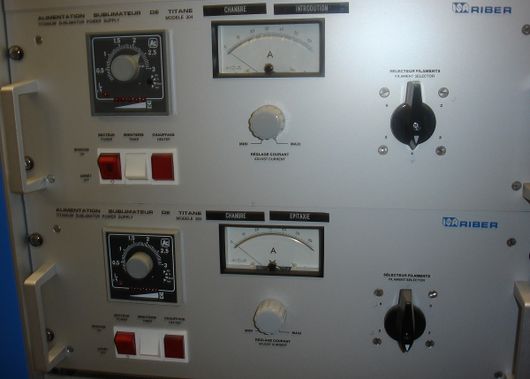
ISA RIBER Mobel JBA 307 S0/2 Electrometers
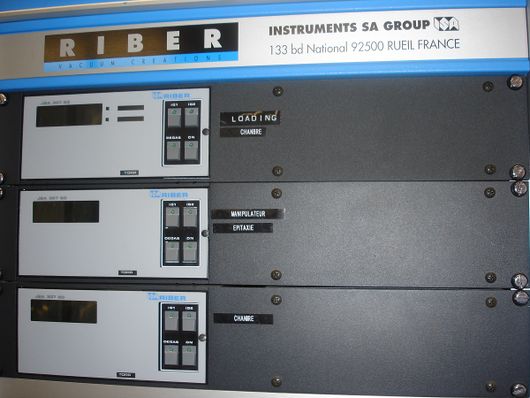
Electrometers display the current produced by the Bayard-Alpert (B-A) ionization gauges located in the main and load-lock chambers in meaningful units (torr). See this for a brief explanation of the theory of operation of B-A ionization gauges. The gauges installed in the MBE are the UHV nude type. The electrometers also serve as the control interface for the B-A ionization gauges. Overpressure protection is included, shutting off power to the B-A ionization gauge when the measured pressure exceeds approximately 10-3 torr. See this manual for operation of the electrometer.
Operating the Electrometers and B-A Ionization Gauges
DO NOT attempt to turn on the gauges when the pressure in the chamber is greater than 10-4 torr.
- Turn on the electrometer by pressing the ON button.
- Activate power to the B-A ionization gauge by pressing either IG1 or IG2 buttons (there are two cathodes in each gauge to provide failover).
- Deactivate power to the B-A ionization gauges by pressing the illuminated IG1 or IG2 button.
- Turn off the electrometer by pressing the illuminated ON button.
Degassing the B-A Ionization Gauge
If the chamber has become badly contaminated as a result of extended exposure to atmosphere or other event, or if the B-A gauges have been in continual operation for a very long period of time, the anode will likely need to be degassed. Press the DEGAS button on the electrometer to activate the degas circuit and leave in this mode for 10-15 minutes. While degassing, the reading on the electrometer will vary, potentially quite a lot, until condensed gas is driven from the anode.
Standard Operating Procedure
The standard operating procedure for the MBE system is described below in details. The steps should be followed exactly during every sequence
Venting Loadlock
- Ensure that the gate valve between the deposition and loadlock chamber is closed.
- Turn off the loadlock chamber ion gauge.
- Close the pneumatic gate valve on the loadlock turbomolecular pump inlet.
- Close the backing gate valve to the loadlock and evaporation chamber turbomolecular pumps.
- Unscrew the latch on loadlock chamber door (this will prevent positive pressure build up while venting with Nitrogen).
- Wait for 5 mins after the ion gauge has been turned off (this is required for cooling down the filament)
- Check the pressure in the Nitrogen regulator (~ 20 psi). Turn the cylinder knob toward the N2 purge pipe. Open N2 valve on the loadlock chamber, flow nitrogen slowly into the chamber while keeping an eye on loadlock TMP motor load. Close the valve if the TMP load increases.
- Once the chamber is vented the loadlock door will open up. Carefully unload the sample holder. At this point close the door and the latch. Keep it this way until the next sample is ready to load.
Roughing Load-lock
- Open the load-lock door and place the sample holder on the loading arm with the sample facing towards the back of the room.
- Close load-lock door and lightly tighten knob.
- Ensure both TMP backing valves are closed.
- Open the load lock roughing valve with a 3/4" wrench and then open fully. Wait for the backing pressure to go below 100 mtorr and start closing the load lock roughing valve. Fully close the roughing valve when the backing pressure is 30 mtorr or less. Close the roughing valve using a 3/4" wrench
- Open the load-lock and evaporation chamber TMP backing valves.
- Open the pneumatic gate valve on the load-lock TMP inlet.
- Turn on the load-lock chamber ion gauge.
- Transfer the sample into the evaporation chamber only after load-lock pressure has reached 5x10-7torr or less.
Unloading Sample
- Once the deposition is done rotate the sample to 135o(this angle may vary slightly).
- Use the robot hand to pull out the sample from the main chamber to the loadlock.
- Wait for the sample to cool down
Venting main Chamber
- Close the manual valve to the main chamber.
- Close the pneumatic valve to the loadlock.
- Shut down both of the ion gauges
- Shut down the ion pump and the titanium sublimation pump
- Unscrew the latch on loadlock chamber door (this will prevent positive pressure build up while venting with Nitrogen)
- Wait for 5 mins after the ion gauge has been turned off (this is required for cooling down the filament)
- Check the pressure in the Nitrogen cylinder(It should be around 20 psi). Turn the cylinder knob toward the N2 flowing pipe. Flow nitrogen slowly into the chamber while keeping an eye on how much load the pump is taking.
- Once the chamber is vented the loadlock door will open up.
Roughing System
BOC Edwards QDP Drystar Roughing Pump
Roughing is provided by a BOC Edwards QDP Drystar vacuum pump. The foreline has three connection points, backing for each of the turbomolecular pumps and roughing at the load-lock chamber. All connection points are individually valved with manually operated Isa Riber isolation valves.
The roughing pump operates continuously while the system is under vacuum.
ISA RIBER JTC 6 T Thermocouple Gauge
ISA RIBER JTC 6 C Power Supply
Component Suppliers
ISA Riber Company - Riber's Website
SVT Associates, Inc. - SVT's Website
k-Space Associates, Inc. - KSA's Website
TLI Enterprises, Inc. "Thermionics" - Thermionic's Website
Inficon - Inficon's Website

